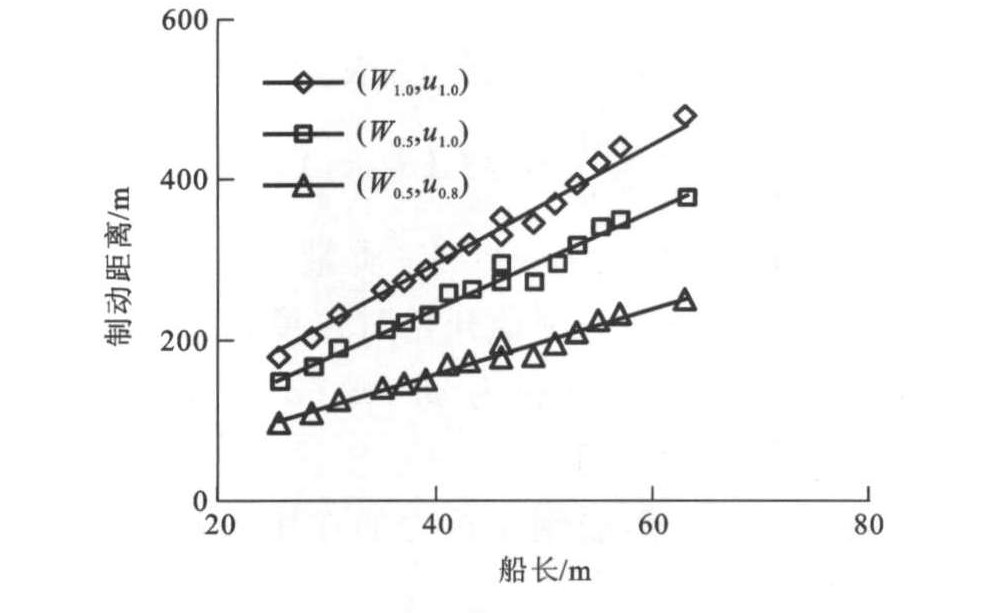-
摘要: 为研究内河船舶流特性, 基于船舶制动机理, 分析了船舶制动距离与船长、航速的相关性, 给出了制动距离的经验公式, 考虑驾驶员经验对实际制动距离的影响, 建立了船舶跟驰间距模型。结合江苏地区机动单船、顶推船队、拖驳船队3类船型实例分析, 通过与内河船舶领域长轴经验值、100t机动单船的分段线性模型结果的对比, 确定了间距模型参数。研究结果表明: 3类船型的制动距离分别与单船、船队、最大单驳长度相关, 计算长度系数分别为5.98、2.73、17.41, 前2类船型的制动距离与航速的平方成正比, 拖驳船队与航速的0.85次方成正比; 驾驶员的制动操作系数、操作指数应取0.78、2.5。Abstract: In order to study the characteristics of inland ship flow, the correlation among breaking distance, ship length and speed was analyzed, the empirical equation of breaking distance was given based on ship breaking mechanism.The impact of operator experience on actual breaking distance was considered, and the following distance model of inland ship was established.Combined with instance analysis including single motorship, pushing fleet and towing fleet in Jiangsu, the parameters of following distance model were determined by analyzing the empirical value of major axis for inland ship domain and the computing value of piecewise linear model of 100 t single motorship.Analysis result shows that the breaking distances of 3 ship categories are related to the lengths of single ship, fleet and the longest barge, and the calculated length coefficients are 5.98, 2.73 and 17.41 respectively.The breaking distances of single motorship and pushing fleet are in direct proportion to the square of ship speed, the breaking distance of towing fleet is in direct proportion to the 0.85 th power of ship speed.The breaking operation coefficient and index of ship operator are determined as 0.78 and 2.5 respectively.
-
表 1 内河航道船舶领域研究成果
Table 1. Research results of ship domain in inland waterway
研究者 船舶种类 纵向长度 横向长度 研究方法 徐周华 进江海船 (3~4)Lm (0.5~0.8)Lm 理论分析, 结合实船试验 顶推船队 (2~3)Lf 0.4Lf 刘绍满 长40 m的单船居多 4.8Lm 3.2Lm 长江镇江段, 雷达图像 (3.2~4.5)Lm (2.5~3.6)Lm 主观问卷调查 周崇喜 3 000 t以下单船为主 3.4Lm 3.2Lm 长江航道, 船员问卷调查 童亮 单船 (2~4)Lm 苏南运河, 理论分析 拖驳船队 (2~4)Lb+Lf 表 2 跟驰间距模型计算参数
Table 2. Calculation parameters of ship-following distance model
船舶(队) sm/m tr/s kb α uf/(km·h-1) n m 机动单船 10 10 0.78 5.98 13.0 2.5 2.00 顶推船队 25 10 0.78 2.73 12.0 2.5 2.00 拖驳船队 25 10 0.78 17.41 8.5 2.5 0.85 表 3 代表船型船舶流参数
Table 3. Ship flow parameters of representative ship types
船舶(队) 序号 吨级/t nb/艘 Lm或Lb/m Lt/m Lc/m uf/(km·h-1) ρf/(艘·km-1) qf/(艘·h-1) ρj/(艘·km-1) ue/(km·h-1) ρe/(艘·km-1) qe/(艘·h-1) Qe/(104 t·h-1) γq, f 机动单船 1 100 1 25.5 25.5 25.5 13.0 5.2 68.2 28.2 7.5 15.0 113.1 1.13 0.60 2 300 1 37.0 37.0 37.0 13.0 3.9 50.8 21.3 7.4 12.4 91.1 2.73 0.56 3 500 1 46.0 46.0 46.0 13.0 3.3 42.4 17.9 7.3 10.8 79.1 3.96 0.54 4 1 000 1 80.0 80.0 80.0 13.0 2.0 26.0 11.1 7.2 7.4 52.9 5.29 0.49 5 2 000 1 90.0 90.0 90.0 13.0 1.8 23.4 10.0 7.2 6.7 48.2 9.64 0.49 顶推船队 6 300 2 30.0 82.0 82.0 12.0 6.4 76.2 18.7 8.1 12.5 101.7 3.05 0.75 7 500 2 42.0 108.0 108.0 12.0 5.0 60.6 15.0 8.0 10.3 83.2 4.16 0.73 8 1 000 2 66.0 161.0 161.0 12.0 3.6 42.7 10.8 7.9 7.7 60.7 6.07 0.70 9 2 000 2 75.0 180.0 180.0 12.0 3.2 38.6 9.8 7.9 7.0 55.4 11.07 0.70 拖驳船队 10 100 11 25.0 298.0 25.0 8.5 16.0 136.3 34.1 6.5 23.0 149.2 1.49 0.91 11 300 6 30.0 210.0 30.0 8.5 9.0 76.6 25.5 5.6 17.1 95.7 2.87 0.80 12 500 5 40.5 231.0 40.5 8.5 6.0 51.2 19.5 5.2 13.2 69.1 3.45 0.74 13 1 000 3 54.0 186.0 54.0 8.5 3.1 26.3 14.2 4.5 9.6 43.5 4.35 0.61 -
[1] 刘绍满, 王宁, 吴兆麟. 船舶领域研究综述[J]. 大连海事大学学报, 2011, 37(1): 51-54. doi: 10.3969/j.issn.1671-7031.2011.01.012LIU Shao-man, WANG Ning, WU Zhao-lin. Review of research on ship domain[J]. Journal of Dalian Maritime University, 2011, 37(1): 51-54. (in Chinese). doi: 10.3969/j.issn.1671-7031.2011.01.012 [2] 刘明俊, 万长征. 航道通过能力影响因素的分析[J]. 船海工程, 2008, 37(5): 116-118. doi: 10.3963/j.issn.1671-7953.2008.05.033LIU Ming-jun, WAN Chang-zheng. Analysis of the factors affecting traffic capacity of navigation channel[J]. Ship and Ocean Engineering, 2008, 37(5): 116-118. (in Chinese). doi: 10.3963/j.issn.1671-7953.2008.05.033 [3] 邵长丰, 方祥麟. 船舶交通流的流体模型[J]. 大连海事大学学报, 2002, 28(1): 52-55. doi: 10.3969/j.issn.1006-7736.2002.01.014SHAO Chang-feng, FANG Xiang-lin. Fluid mechanics model for vessel traffic flow[J]. Journal of Dalian Maritime University, 2002, 28(1): 52-55. (in Chinese). doi: 10.3969/j.issn.1006-7736.2002.01.014 [4] 董宇, 姜晔, 何良德. 内河航道通过能力计算方法研究[J]. 水运工程, 2007(1): 59-65. doi: 10.3969/j.issn.1002-4972.2007.01.015DONG Yu, JIANG Ye, HE Liang-de. Calculation method of inland waterway's throughput capacity[J]. Port and Water-way Engineering, 2007(1): 59-65. (in Chinese). doi: 10.3969/j.issn.1002-4972.2007.01.015 [5] 余劲. 基于交通流理论的内河航道通过能力研究[D]. 南京: 河海大学, 2007.YU Jin. Research on inland waterway capacity based on traf-fic flow theory[D]. Nanjing: Hohai University, 2007. (in Chinese). [6] 朱俊, 张玮. 基于跟驰理论的内河航道通过能力计算模型[J]. 交通运输工程学报, 2009, 9(5): 83-87. doi: 10.3321/j.issn:1671-1637.2009.05.015ZHU Jun, ZHANG Wei. Calculation model of inland water-way transit capacity based on ship-following theory[J]. Journal of Traffic and Transportation Engineering, 2009, 9(5): 83-87. (in Chinese). doi: 10.3321/j.issn:1671-1637.2009.05.015 [7] 朱俊. 基于船舶流的交通时间阻抗模型[J]. 武汉理工大学学报: 交通科学与工程版, 2010, 34(3): 591-594. doi: 10.3963/j.issn.1006-2823.2010.03.041ZHU Jun. Traffic impedance model based on vessel traffic flow[J]. Journal of Wuhan University of Technology: Transportation Science and Engineering, 2010, 34(3): 591-594. (in Chinese). doi: 10.3963/j.issn.1006-2823.2010.03.041 [8] 朱俊, 张玮, 唐磊. 内河船舶流当量系数研究[J]. 水运工程, 2010(2): 40-45. doi: 10.3969/j.issn.1002-4972.2010.02.010ZHU Jun, ZHANG Wei, TANG Lei. Study on vessel equiv-alent for inland waterways[J]. Port and Waterway Engineering, 2010(2): 40-45. (in Chinese). doi: 10.3969/j.issn.1002-4972.2010.02.010 [9] 朱俊, 张玮, 何良德, 等. 内河航道服务水平研究[J]. 中国港湾建设, 2009(2): 4-6, 20. doi: 10.3969/j.issn.1003-3688.2009.02.002ZHU Jun, ZHANG Wei, HE Liang-de, et al. Research on service level of inland waterways[J]. China Harbour Engin-eering, 2009(2): 4-6, 20. (in Chinese). doi: 10.3969/j.issn.1003-3688.2009.02.002 [10] 童思陈, 许光祥, 邓明文. 澜沧江船舶航行阻力及通航水力指标研究[J]. 人民长江, 2010, 41(2): 67-72. doi: 10.3969/j.issn.1001-4179.2010.02.017TONG Si-chen, XU Guang-xiang, DENG Ming-wen. Study on sailing resistance and navigable hydraulic parameters to rapids shoal of Lancang River[J]. Yangtze River, 2010, 41(2): 67-72. (in Chinese). doi: 10.3969/j.issn.1001-4179.2010.02.017 [11] 李一兵. 内河船舶航行阻力计算方法讨论[J]. 水道港口, 2002, 23(1): 7-11. doi: 10.3969/j.issn.1005-8443.2002.01.002LI Yi-bing. Discussion on the method of inland ship sailing resistance calculation[J]. Journal of Waterway and Harbour, 2002, 23(1): 7-11. (in Chinese). doi: 10.3969/j.issn.1005-8443.2002.01.002 [12] 徐周华, 牟军敏, 季永清. 内河水域船舶领域三维模型的研究[J]. 武汉理工大学学报: 交通科学与工程版, 2004, 28(3): 380-383.XU Zhou-hua, MU Jun-min, JI Yong-qing. A study of 3D model of ship domain for inland waterway[J]. Journal of Wuhan University of Technology: Transportation Science and Engineering, 2004, 28(3): 380-383. (in Chinese). [13] 刘绍满. 内河船舶拥挤水域通过能力的研究[D]. 大连: 大连海事大学, 2006.LIU Shao-man. The research of the inland river channel transit capacity where ship is crowed[D]. Dalian: Dalian Maritime University, 2006. (in Chinese). [14] 周崇喜. 内河航道船舶通航能力研究[D]. 武汉: 武汉理工大学, 2006.ZHOU Chong-xi. The research of the interior water route's navigation ability[D]. Wuhan: Wuhan University of Technology, 2006. (in Chinese). [15] PIETRZYKOWSKI Z, URIASZ J. The ship domain—a criterion of navigational safety assessment in an open sea area[J]. Journal of Navigation, 2009, 62(1): 93-108. doi: 10.1017/S0373463308005018 [16] PIETRZYKOWSKI Z. Ship's fuzzy domain—a criterion for navigational safety in narrow fairways[J]. Journal of Navigation, 2008, 61(3): 499-514. doi: 10.1017/S0373463308004682 [17] 童亮. 苏南运河岸线控制利用的理论研究[D]. 南京: 河海大学, 2006.TONG Liang. Theoretical research of control and using of canal shore on the grand canal in the south of Jiangsu Province[D]. Nanjing: Hohai University, 2006. (in Chinese). -





 下载:
下载:










